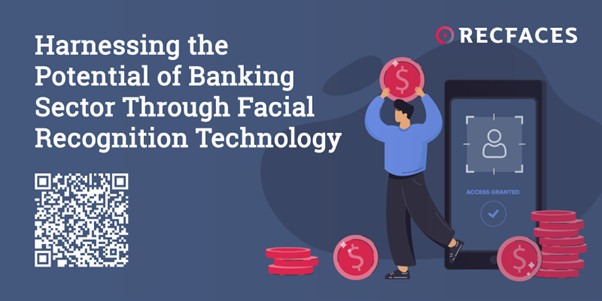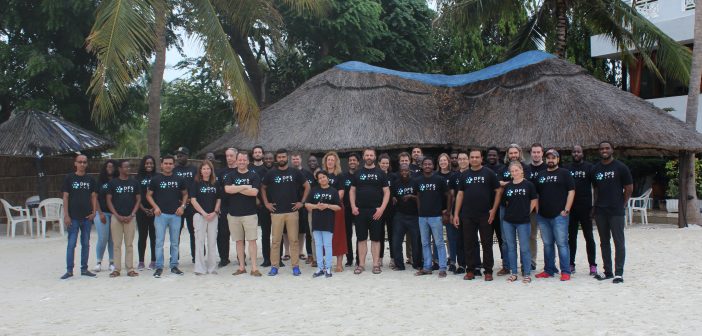Harnessing the Potential of Banking Sector Through Facial Recognition Technology

As the world moves online, banking is keeping pace with the changing technology through its own trail of transformation. This transformation has been especially prominent in the last decade, with rapid digitisation and increased focus on agility in processes. As a by-product of the changing landscape of banking, concerns related to information security, adoption and trust loom. Online fraud, for instance, is increasing as a result of a shift towards online banking. Not to mention the hassles of remembering numerous passwords, stacking physical cards, and long waiting hours in the physical bank branches.
Factors that hinder the user’s ease and sense of trust is a challenge to customer success in banking. The essence of banking services is providing aid in financial management, frictionless access and security. With higher trust in the banking system, customers tend to invest time and resources in bank services for wealth growth. So, banks are increasingly emphasising the use of technology that can help reduce frauds, facilitate customer convenience, mitigate losses, keep the sensitive information safely stored, and contribute to the evolution of banking processes.
Facial Recognition Technology in Banking
Facial recognition biometrics is the AI-powered technology that enables identification of a person by accessing their facial features. Biometrics have been a part of the banking processes for a long time. Facial biometrics offer promising possibilities of a momentous revolution in the banking sector. It has applications in diverse banking processes to elevate transaction security, process lifecycle, and customer success. Some of its key features are:
- easy to implement and use
- highly accurate
- prompt identification
- contactless
- utility across processes
According to a study by PYMNTS, 52% of the customers view biometrics as more secure for authenticating transactions as compared to other methods of authentication. However, the immense potential unlocked through facial biometrics, is yet confined to limited exploration.
Facial Recognition System Embarking upon the Key Challenges in Banking
Physical Security
Physical security in bank branches struggles due to high footfall, vulnerability to robbery and theft, security breaches and outdated surveillance systems. The pertinent threats of the loss of resources and unauthorised access to sensitive infrastructure create insecurity within the users. This calls for a more efficient access control and security system. Additionally, identity checks, record verification and authentication are key parts of the KYC protocol. While secure banking is facilitated through fingerprint biometrics, it is susceptible to manipulation, proximity and hygiene limitations.
Facial biometrics-enabled systems hedge these limitations to provide a more coherent security solution. Customer identification can be a cumbersome task at the expense of security staff and dealing during busy hours. Facial recognition systems are expeditious in identification of each and every person walking through the doors, irrespective of the crowd density. It also facilitates intelligent access control and management of accounts of staff members and customers. Allowing the set up of account perimeters, access permissions, level of control, and black list, FRS is extremely useful in strengthening the physical security infrastructure.
Customer Convenience
Digitisation is gradually and rapidly taking over the banking processes. While mobile banking enables remote account access and real-time transactions, it inevitably adds to the hassles of the customers in terms of maintaining passwords and account authentication. According to research by NordPass, a person has to remember 70-80 passwords on an average. Not to mention that physical ATM cards, passbooks and documents can be easily lost or stolen. In case any customer loses vital information, the re-authentication can be arduous. So, the inconveniences persist in the form of long waiting hours in queues, delays in issue redressal, and lack of personalised services. Such difficulties weaken the customers’ trust on the bank’s services, making customer retention a challenge.
Facial Recognition System (FRS), as an added security modality, adds to customer convenience as well. Solutions enabled with advanced facial recognition algorithms for accurately identifying user accounts, increase the efficacy of in-branch processes, and streamline customer on-boarding and verification. Its liveness detection feature helps prevent frauds in the event of loss and theft of cards, SIM cloning and data leaks. It also permits creating digital IDs that encrypt details like digital signatures, demographics, vaccinations and customer profile allowing smooth online and offline authentication. Introducing facial biometrics in the client identity lifecycle process enables quick account retrieval.
Digital Security
Juniper predicts that by 2028, the value of transactions executed by digital wallet will reach USD 16tn. Evidently, mobile and neo banking are picking up momentum to become the new normal. But the adoption of digital banking comes with the pertinent challenge of online frauds. Due to its nature, digital banking is highly vulnerable to losses through frauds, identity thefts, embezzlement, spoofing and phishing attacks. Customer verification is another key part of the online banking regime to make sure of legitimacy during the on-boarding process. Without constructive protocols and solutions in place, the risks of synthetic identity frauds soar.
Facial recognition systems allow storing the sensitive data in-house and regular automated updates to the accounts details, acting as a powerful step in the multi-factor contactless authentication regime. In multiple reports, people approved that facial biometrics can improve safety in banking. According to VISA, it was found that over 53% of total credit card users are willing to change their bank if the current bank refuses application of biometric authentication in mobile banking. Facial biometrics can not be easily duped and provide an agile alternative to secure digital currency and wallets. With exceptional potential in account access control, identification and verification, it also efficiently traces and records attempts of breach.
Transformation for Banks through FRS
The biometric banking market is expected to value at USD 23.6 Billions by 2032. This indicates the Compound Annual Growth Rate (CAGR) of 17.2% between 2023 and 2032. Technology is as good as its usefulness to the users. According to the experts in Deloitte Center for Financial Services, frauds pertaining to synthetic identity are expected to cause losses up to USD 23bn by 2030. Facial recognition with liveness detection is a game changing security technology. High reliability allows more monetary transactions, encouraging banks to expand their business & provide more tailored services to increase banking inclusion. It reinforces security in virtual services, in branch transactions and augments trust through enhanced holistic experience.
“Facial Recognition is a breakthrough technology for banks. Not only does it make fraud detection and mitigation fast and effective, but it can do wonders to accelerate financial inclusion while providing a more secure and seamless customer experience.” – Valerie Lapteva, Business Development Director, APAC region, RecFaces.
“Facial biometrics is an inseparable module of the Zero-trust security model. It can strongly reinforce the banking ecosystem with a hard-to-compromise technology at every point in the physical and digital security channels.” – Sukrit Varma, Global Marketing Partner, APAC and MENA regions, RecFaces.







